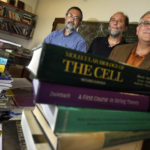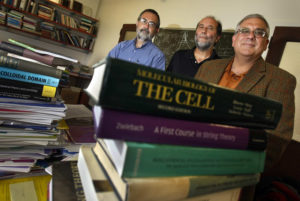
The University of California at San Diego faced a losing battle recently when it tried to hang on to three star scientists being wooed by Rice University for cutting-edge cancer research.
The recruiting package from the private Houston university included 40-percent pay raises, new labs, and a healthy flow of research money from a Texas state bond fund. But another factor, unrelated to Rice, helped close the deal: The professors’ sense that declining state funding for the University of California made it a good time to pack their bags.
“What’s happening now is that the UC and most of the public schools are getting in a much weaker position to play this game,” said physicist Jose Onuchic, who has taught at UC San Diego for 22 years but will head to Texas this month, along with fellow physicist Herbert Levine and biochemist Peter Wolynes.
The imminent departures of the three—all members of the prestigious National Academy of Sciences—has unsettled leaders of the UC system. Officials say a worsening UC budget picture is emboldening other schools, particularly top private institutions, to recruit UC faculty and might prompt other professors to leave as well.
“It’s like piranha. They sense blood in the water,” Gene Lucas, UC Santa Barbara’s executive vice chancellor, said of the recruiting institutions, which increasingly include overseas universities.
UC officials say that, so far, they have managed to fend off most raids in a system that employs about 18,000 faculty members.
But matching the growing number of outside offers comes at a cost, using funds that could help fill vacancies and hire additional professors. And when they don’t succeed, grant money often moves with the departing researcher, along with a dose of academic prestige.
Daniel Simmons, a UC Davis law professor who is chairman of the UC system’s Academic Senate, called Rice’s success in recruiting the San Diego trio “a stunning example of where we are losing” and said the numbers of such departures could increase.
UC Davis, for example, saw the number of firm outside offers to faculty double to 61 this year from last, and its retention rate drop from 90 percent to 72 percent as it lost professors to such universities as Brown, New York University, Penn State, and Rice, according to Barbara Horwitz, vice provost for academic affairs. Those schools are pursuing established experts at UC in part “because there is so much uncertainty in the state,” she said.
At UC Santa Barbara, the number of recruitment attempts rose 15 percent this year to about two dozen, according to Lucas. UC Santa Barbara tries to match the offers as much as possible, but it could not compete with two packages from a Swiss university that doubled the salaries of professors in science and engineering. Others on campus said it was the elite Swiss Federal Institute of Technology Zurich.
Last year, about 75 percent of UC faculty who received firm offers from other schools were persuaded to stay, about the same as in recent years, according to Lawrence H. Pitts, the UC system’s provost and executive vice president for academic affairs. This year’s figures were not yet available, but Pitts said he did not expect much change.
However, he and other UC leaders are concerned about the university’s ability to keep top talent in a tough budget climate. “The chance of having more recruiting and retention problems in a year is entirely possible,” Pitts said. “We are all worried about it.”
A recent report to the UC regents showed a troubling trend. Of tenured professors hired in 2000-01, 28 had left UC eight years later, compared with 19 hired the previous year, the study said. The most common destinations were Stanford, NYU, USC, Columbia, and Harvard—private schools that tend to pay more—and the University of Michigan, a top public university.
The rise in departures of tenured professors “is of particular concern, because these are high-quality faculty in whom UC has made a substantial investment,” the authors wrote. In addition, new faculty hires dropped from 607 in 2008-09 to 379 last year, the most recent figures available.
Private research universities increasingly pay professors more than public institutions, with the gap growing from an 8-percent advantage in 1980 for full professors at private doctoral-granting schools to about 25 percent this year, according to the American Association of University Professors. Private schools’ growing use of the wage gap to lure faculty hires “is definitely an issue nationally,” said John W. Curtis, director of research and public policy for the faculty group.
At Rice, Provost George McLendon said his school focused on the San Diego trio as it sought the best physicists and other scientists for cancer research. “It wasn’t about targeting the University of California, but it was targeting some specific people who could help us move forward in a much faster way,” he said.
McLendon said he hoped California resolves its budget problems. “In the meantime, my job isn’t to figure out how to help the University of California,” he said. “My job is to make Rice University even greater.”
Suresh Subramani, UC San Diego’s executive vice chancellor for academic affairs, called the departures serious, but added: “If we didn’t have other universities interested in our faculty, I would begin to wonder whether we were doing something wrong.”
UC San Diego has fended off about 90 percent of the raids, yet Subramani worries that the price is “mortgaging the future.” He declined to specify his unsuccessful counteroffers to the three men.
Onuchic, who is co-director of UC San Diego’s Center for Theoretical Biological Physics, said he was drawn to Rice mainly for the research funds and new building, along with the chance to work with cancer experts in Houston.
“The opportunities were spectacular,” said Onuchic, whose research focuses on protein movement and chemical reactions in gene networks. His UC salary, including summer grants, is $265,000; he and his colleagues said Rice would give them 40-percent increases.
The three scientists are expected to take with them much of their National Science Foundation grant, which has paid $6.6 million since 2008 and is expected to provide several million more over the next two years. At Rice, their funding will also include a $10 million grant from the Cancer Prevention and Research Institute of Texas, created with a $3 billion state bond issue approved by voters in 2007.
Levine, 55, who has been at UC San Diego for 25 years and earns $187,000 a year, said Rice’s new and larger lab space and extra administrative support was too good to turn down. Another factor is that Rice, which has a fifth of UC San Diego’s 27,417 students, is much less bureaucratic, he added.
Wolynes, 58, is a 10-year veteran of UC San Diego and earns $330,000 a year. Moving together keeps the team intact—it’s a “Three Musketeers situation,” he said—and the Texas cancer money will mean less hustling for grants. He still greatly admires UC, he said, but believes its “period of expansion” might be over.
UCLA and UC Berkeley reported no significant change in outside recruiting this year, and some experts said that because the two campuses are seen as the most prestigious in the UC system, faculty might be more reluctant to leave.
Nevertheless, Scott Waugh, UCLA’s executive vice chancellor and provost, said concerns about state finances loom larger these days in faculty decisions to stay or move to UC, along with traditional factors of family and housing.
For example, UC Berkeley political science professor Wendy Brown said she was considering an attractive offer from Columbia University. UC has said it would match the 12-percent pay increase, but she said she has not asked Berkeley for the extra research and housing funds that the private New York school is offering.
Brown said it was a difficult decision for many UC faculty, because “we love the idea of a public university” and especially one of UC’s quality. Yet Brown, who has taught at UC Berkeley since 1999 and at UC Santa Cruz for the preceding 10 years, fears budget cuts could turn UC into a factory-like school.
Other universities, she said, are taking advantage of that uncertainty: “I think they believe UC people are not barnacles attached to the ship anymore.”
Copyright (c) 2011, Los Angeles Times. Visit the Los Angeles Times on the internet at http://www.latimes.com/. Distributed by McClatchy-Tribune Information Services.
- Extron AV Switching, Streaming, and Control Systems Aid Higher Learning at Idaho’s First Medical School - June 1, 2021
- Extron XTP, Streaming, and Control Systems Empower Point Park University’s Varsity Esports Program - June 1, 2021
- Extron NAV Series Delivers AVoIP Throughout Allied Health Veterans Hall at UNC Wilmington - June 1, 2021

